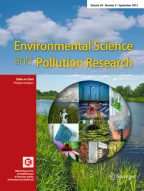Abstract
Although rainwater harvesting (RWH) schemes have gradually gained more credibility and popularity in recent times, efficient utilisation and larger scale implementation of multi-purpose RWH are still a challenging task. This paper aims to explore the potential of using smart RWH schemes and their impact on the efficiency improvement in integrated urban water systems (UWS). The smart RWH scheme analysed here is capable of proactively controlling the tank water level to ensure sufficient spare storage is maintained at all times that accommodates the runoff from storm events. The multi-purpose RWH tank can mitigate local floods during rainfall events and supply harvested rainwater to non-potable residential water consumption. Optimal design parameters of the smart RWH scheme are also identified to achieve the best operational performance of the UWS. WaterMet2 model is used to assess the performance of the UWS with smart RWH schemes. The efficiency of the proposed methodology is demonstrated through modelling a real case of integrated UWS. The results obtained indicate that utilisation of smart RWH with an optimally sized tank, compared to the corresponding conventional RWH, is able to significantly improve the UWS efficiency in terms of mitigation of local flooding and reliability of water supply from harvested rainwater.
Similar content being viewed by others
Explore related subjects
Discover the latest articles, news and stories from top researchers in related subjects.References
Basupi I, Kapelan Z, Butler D (2014) Reducing life-cycle carbon footprint in the (re)design of water distribution systems using water demand management interventions. Urban Water J 11(2):91–107
Behzadian K, Kapelan Z (2015a) Advantages of integrated and sustainability based assessment for metabolism based strategic planning of urban water systems. Sci Total Environ 527:220–231
Behzadian K, Kapelan Z (2015b) Modelling metabolism based performance of an urban water system using WaterMet2. Resour Conserv Recycl 99:84–99
Behzadian K, Kapelan Z, Savic D, Ardeshir A (2009) Stochastic sampling design using a multi-objective genetic algorithm and adaptive neural networks. Environ Model Softw 24(4):530–541
Behzadian K, Kapelan Z, Venkatesh G, Brattebø H, Sægrov S, Rozos E, Makropoulos C (2014a) Quantitative UWS performance model: WaterMet2 TRUST project report, Deliverable D33.2 (https://www.trust-i.net/)
Behzadian K, Kapelan Z, Morley MS (2014b) Resilience-based performance assessment of water-recycling schemes in urban water systems. Procedia Eng 89:719–726
Bouziotas D, Rozos E, Makropoulos C (2015) Water and the city: exploring links between urban growth and water demand management. J Hydroinf 17(2). https://doi.org/10.2166/hydro.2014.053
BSI (2013) BS 8515:2009+A1:2013 rainwater harvesting systems—code of practice. BSI, London
Chiu YR, Liaw CH, Tsai YL (2009) Harvesting rainwater, an innovative approach to easing urban water-energy dilemma. Proceedings of the 14th International Conference on Rainwater Catchment Systems, Kuala Lumpur
Deb K, Pratap A, Agarwal S, Meyarivan TAMT (2002) A fast and elitist multiobjective genetic algorithm: NSGA-II. IEEE Trans Evol Comput 6(2):182–197
Eroksuz E, Rahman A (2010) Rainwater tanks in multi-unit buildings: a case study for three Australian cities. Resour Conserv Recycl 54(12):1449–1452
Imteaz MA, Ahsan A, Naser J, Rahman A (2011) Reliability analysis of rainwater tanks in Melbourne using daily water balance model. Resour Conserv Recycl 56(1):80–86
Jones MP, Hunt WF (2010) Performance of rainwater harvesting systems in the southeastern United States. Resour Conserv Recycl 54(10):623–629
Karamouz M, Behzadian K, Zahraie B, Kerachian R (2003) An evolutionary model for operation of hydropower reservoirs. World Water and Environmental Resources Congress ASCE, Philadelphia. https://doi.org/10.1061/40685(2003)150
Khastagir A, Jayasuriya N (2010) Optimal sizing of rain water tanks for domestic water conservation. J Hydrol 381(3):181–188
Maidment DR (1992) Handbook of hydrology. McGraw-Hill, New York
Makropoulos CK, Natsis K, Liu S, Mittas K, Butler D (2008) Decision support for sustainable option selection in integrated urban water management. Environ Model Softw 23(12):1448–1460
Mitchell VG, Diaper C (2010) UVQ user manual: urban water balance and contaminant balance analysis tool, Version 1.2, CMIT Report No. 2005–282 CSIRO
Nolde E (2007) Possibilities of rainwater utilisation in densely populated areas including precipitation runoffs from traffic surfaces. Desalination 215:1–11
Partzsch L (2009) Smart regulation for water innovation—the case of decentralized rainwater technology. J Clean Prod 17(11):985–991
Peel M, Finlayson B, McMahon T (2007) Updated world map of the Köppen–Geiger climate classification. Hydrol Earth Syst Sci 11:1633–1644
Rozos E, Makropoulos C (2013) Source to tap urban water cycle modelling. Environ Model Softw 41:139–150
Rozos E, Makropoulos C, Butler D (2010) Design robustness of local water recycling schemes. J Water Resour Plann Manag ASCE 136(5):531–538
Tchobanoglous G, Burton FL, Stensel HD (2003) Metcalf & Eddy, Inc wastewater engineering: treatment and reuse. McGraw-Hill, New York
Venkatesh G, Sægrov S, Brattebø H, Behzadian K, Kapelan Z (2015) Metabolism modelling approaches to long-term sustainability assessment of urban water services. Urban Water J. https://doi.org/10.1080/1573062X.2015.1057184
Wang Q, Guidolin M, Savic D, Kapelan Z (2014) Two-objective design of benchmark problems of a water distribution system via MOEAs: towards the best-known approximation of the true Pareto front. J Water Resour Plan Manag 141(3):04014060
Ward S, Memon FA, Butler D (2012) Performance of a large building rainwater harvesting system. Water Res 46(16):5127–5134
Zaizen M, Urakawa T, Matsumoto Y, Takai H (1999) The collection of rainwater from dome stadiums in Japan. Urban Water J 1:355–359
Acknowledgements
Part of this work is related to the software tool of WaterMet2 which was developed between 2012 and 2015 in the ‘TRansition to Urban water Services of Tomorrow’ (TRUST) research project funded under the Seventh Framework Programme by the European Commission, which is gratefully acknowledged. Readers interested to use WaterMet2 software tool for research purposes may contact the authors.
Author information
Authors and Affiliations
Corresponding author
Additional information
Responsible editor: Philippe Garrigues
Rights and permissions
About this article
Cite this article
Behzadian, K., Kapelan, Z., Mousavi, S.J. et al. Can smart rainwater harvesting schemes result in the improved performance of integrated urban water systems?. Environ Sci Pollut Res 25, 19271–19282 (2018). https://doi.org/10.1007/s11356-017-0546-5
Received:
Accepted:
Published:
Issue Date:
DOI: https://doi.org/10.1007/s11356-017-0546-5
